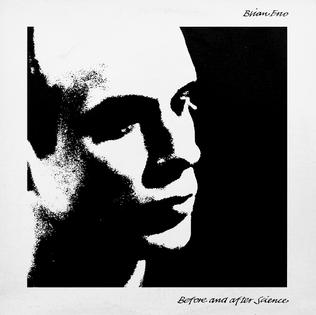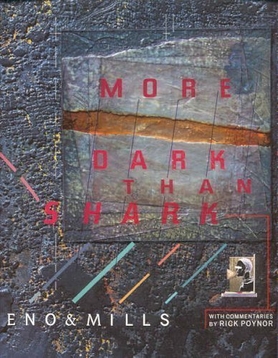
Roxy Music are an English rock band formed in 1970 by lead vocalist and principal songwriter Bryan Ferry and bassist Graham Simpson. By the time the band recorded their first album in 1972, Ferry and Simpson were joined by saxophonist and oboist Andy Mackay, guitarist Phil Manzanera, drummer Paul Thompson and synthesizer player Brian Eno. Other members over the years include keyboardist and violinist Eddie Jobson and bassist John Gustafson. The band split in 1976, reformed in 1978 and split again in 1983. In 2001, Ferry, Mackay, Manzanera and Thompson reunited for a concert tour and have toured together intermittently ever since, most recently in 2022 to celebrate the 50th anniversary of their first album. Ferry has also frequently enlisted band members as backing musicians during his solo career.

Another Green World is the third solo studio album by Brian Eno, released by Island Records on 14 November 1975. The album marked a transition from the rock-based music of Eno's previous releases toward the minimalist instrumentals of his late 1970s ambient work. Only five of its fourteen tracks feature vocals, a contrast with his previous vocal albums.

Before and After Science is the fifth solo studio album by Brian Eno, originally released by Polydor Records in December 1977 in the United Kingdom and by Island U.S. soon after. Produced by Eno and Rhett Davies, it is the first of Eno's popular music works to be published under his full name.
Oblique Strategies is a card-based method for promoting creativity jointly created by musician/artist Brian Eno and multimedia artist Peter Schmidt, first published in 1975. Physically, it takes the form of a deck of 7-by-9-centimetre printed cards in a black box. Each card offers a challenging constraint intended to help artists break creative blocks by encouraging lateral thinking.

Here Come the Warm Jets is the debut solo album by Brian Eno, released on Island Records on 8 February 1974. It was recorded and produced by Eno following his departure from Roxy Music, and blends glam and pop stylings with avant-garde approaches. The album features numerous guests, including several of Eno's former Roxy Music bandmates along with members of Hawkwind, Matching Mole, Pink Fairies, Sharks, Sweetfeed, and King Crimson. Eno employed unusual directions and production methods to coax unexpected results from the musicians.

Phillip Geoffrey Targett-Adams, known professionally as Phil Manzanera, is an English musician, songwriter and record producer. He is the lead guitarist with Roxy Music, and was the lead guitarist with 801 and Quiet Sun. In 2006, Manzanera co-produced David Gilmour's album On an Island, and played in Gilmour's band for tours in Europe and North America. He wrote and presented a series of 14 one-hour radio programmes for station Planet Rock entitled The A-Z of Great Guitarists.

Stranded is the third album by English rock band Roxy Music, released in 1973 by Island Records. Stranded was the first Roxy Music album on which Bryan Ferry was not the sole songwriter, with multi-instrumentalist Andy Mackay and guitarist Phil Manzanera also making songwriting contributions. It is also their first album with keyboardist/violinist Eddie Jobson and bassist John Gustafson, who replaced Brian Eno and John Porter, respectively, after their departures following the release of their previous album For Your Pleasure.

Andrew Mackay is an English musician, best known as a founding member of the art rock group Roxy Music.
801 were an English experimental rock supergroup band, originally formed in London in 1976 for three live concerts by Phil Manzanera, Brian Eno, Bill MacCormick, Francis Monkman, Simon Phillips and Lloyd Watson.
Lloyd Watson was an English rock and blues guitarist.

More Blank Than Frank and Desert Island Selection are 1986 compilation albums of music by Brian Eno. More Blank Than Frank is the title given to the vinyl LP and cassette releases, and Desert Island Selection is the name used for the CD version. The three versions were issued at the same time, though they differ somewhat in the ordering and in the songs that were used. The LP features 10 tracks, the cassette, 12, and the CD, 11.
Rhett Davies is an English record producer and engineer.
"Baby's on Fire" is the third track on English musician Brian Eno's 1974 debut solo album Here Come the Warm Jets.

Diamond Head is the first studio album by English rock musician Phil Manzanera. It was released in 1975, originally on Island Records in the UK and in the US on Atco Records. The sound quality on the US album was deemed to be worse than the UK album, so the UK import became a popular seller in the speciality record shops who sold Roxy Music and other UK bands. The diesel locomotive featured on the cover art is an EMD E9.

Brian Peter George Eno, also mononymously known as Eno, is an English musician, songwriter, record producer and visual artist. He is best known for his pioneering contributions to ambient music and electronica, and for producing, recording, and writing works in rock and pop music. A self-described "non-musician", Eno has helped introduce unconventional concepts and approaches to contemporary music. He has been described as one of popular music's most influential and innovative figures. In 2019, he was inducted into the Rock and Roll Hall of Fame as a member of Roxy Music.
"Slug" is a song by Passengers, a side project of rock band U2 and musician Brian Eno. It is the second track on Passengers' only release, the 1995 album Original Soundtracks 1. The track was originally titled "Seibu" and was almost left off the album before it was rediscovered later during the recording sessions. Though Eno made most of the creative decisions during the recording sessions, "Slug" was one of the few tracks that the members from U2 tried to craft themselves.

More Dark Than Shark is a 1986 book by Brian Eno and Russell Mills. It features the lyrics to Eno's songs, each accompanied by an artwork inspired by the song's lyrics by Mills. Most of the lyrics and artworks are accompanied by notes by Eno and Mills on the lyrics and the interpretation of them as used for the artwork.

(No Pussyfooting) is the debut studio album by the British duo Fripp & Eno, released in 1973. (No Pussyfooting) was the first of three major collaborations between the musicians, growing out of Brian Eno's early tape delay looping experiments and Robert Fripp's "Frippertronics" electric guitar technique.
Experimental pop is pop music that cannot be categorized within traditional musical boundaries or which attempts to push elements of existing popular forms into new areas. It may incorporate experimental techniques such as musique concrète, aleatoric music, or eclecticism into pop contexts. Often, the compositional process involves the use of electronic production effects to manipulate sounds and arrangements, and the composer may draw the listener's attention specifically with both timbre and tonality, though not always simultaneously.
"Third Uncle" is a 1974 song by the English musician Brian Eno, released on his second solo album Taking Tiger Mountain . The song was recorded at Basing Street Studios in Notting Hill, London, in September 1974, and produced by Eno. It has been highly influential and covered by many artists, most notably by Bauhaus in 1982.














